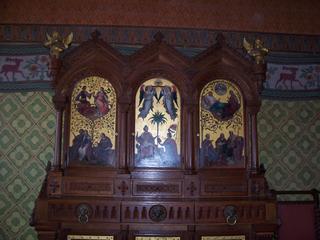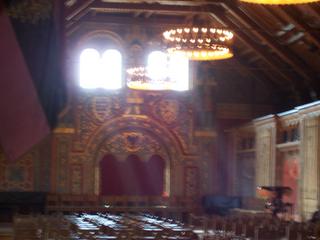Comparing Schloss's II
So I also got to visit the Castle of Wartburg with the international students at the University of Erfurt. This is where Martin Luther hid after being excommunicated by the Catholic Church and where he translated the Bible into German. He had to learn Greek and Hebrew to read the original Bible, and then he had to bring together almost 20 German dialects together to have a "german" Bible. Impressive stuff on Luther's part. He did all of this in 6 months. That is determination. The castle itself has a long history along with it that is almost as old as Hohentwiel. It was built in the 11th Century by Ludwig the Jumper. Legend says he jumped out of a prison window giving him his name. He built the castle after finding the peak and its overlook fo major trading routes one while hunting. A good deal of the original castle remains but there are also many additions from later counts.
This is an outlook from the hill the stands on. It overlooks the city of Eisennach (which is also where J.S. Bach was born. We visited his house the same day.)






1 Comments:
Reducing flash glare:
Ya'know those awful thumbprints of light you get in pictures with flash (like the cabinet thingy in the church)?
Whenever you're photographing something head on that's reflective (windows, varnished church cabinets, bald men) reflection and glare are a problem.
2 choices with your little point-and-shoot:
1) Simple (and not an option when you don't want distorted perspective in architecture): Shoot pictures with reflective surfaces at an angle, causing the light from the flash to bounce away from the camera.
2 Harder: Cut a piece of heavy paper (poster-board or a piece of tin) in a rectangle about 1.5 inches x 2.5 inches (I think that's big enough for your camera).
Now, grab some duct tape (or other super-sticky tape). Tape the little flap you've made to the camera's front, covering the flash and extending above the top of the body. To clarify: Tape the flap on one of the short sides, attaching the tape to the camera body below the flash.
Side note: I couldn't get the ASCII 'drawings' I painstakingly made for you to show up correctly (blogger's auto formatting skews them), so if you can't imagine it, I'll send a picture via email. Sucks, really. The 3rd drawing was good, too =(
Now you've got a bounce flash, which is *much* better for taking pictures of reflective things (and people!) indoors. All you have to do is bend the flap forward (right above the tape that's holding it to the camera) so the flash can bounce up towards the ceiling.
You'll have to experiment to find out just how far you need to bend the flap down for best results. Just don't bend it so far down that the flash can illuminate your subject directly.
Make sure you don't cover any little sensors or windows on the camera with the tape, too =P
'Should work like a charm once you fiddle with it =)
Post a Comment
<< Home